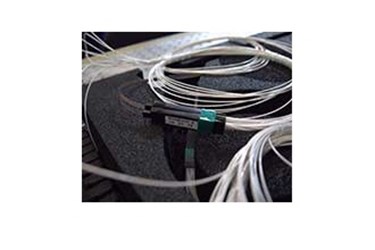Solving The Internet Capacity Crunch: First Demonstration Of A Multicore Fibre Network

With optical fibre networks gradually approaching their theoretical capacity limits, new types of fibres such as multicore fibres have been at the focus of worldwide research to overcome critical capacity barriers, which threaten the evolution of the Internet. The University of Bristol in collaboration with the National Institute of Information and Communications Technology (NICT) have demonstrated successfully for the first time a multicore fibre-based network, which will form the foundation for the future Internet infrastructure.
The research relies on Space Division Multiplexed (SDM) provided by the multicore fibres and on Software Defined Network (SDN) control, which are considered promising solutions to fulfil and control the ever-increasing demand for data consumption in communication networks.
This collaborative work between the High Performance Networks Group at Bristol and NICT, Japan, represents the first successful demonstration of a fully functional multicore fibre network taking advantage of the flexibility and intelligence that SDN can offer in order to provide services to emerging Internet applications such as global cloud computing.
The Bristol research team developed the SDN control based on extensions of the OpenFlow protocol and provided the novel network node equipment while NICT contributed multicore fibres (MCFs) and new transmission techniques based on self-homodyne detection (SHD).
The implemented OpenFlow interface dynamically configures the network nodes in a way that the network can deal more effectively with application specific traffic requirements such as bandwidth and Quality of Transport.
With the growing popularity of OpenFlow, this demonstration is believed to bring multicore fibre networks one big step closer to their practical realisation.
Professor Dimitra Simeonidou, Head of the High Performance Networks Group at the University of Bristol, said: “Although most on-going research has been concentrating solely on the improvement of data throughput and transmission distance of point-to-point links, it has become apparent that the success of new fibre technologies will be strongly governed by its applicability to optical networks together with an adequate control of all required network functions.
“From the viewpoint of network control, Software Defined Networking (SDN) has been recently gaining increasingly attention as a technology that enables network operators to easily adapt their network infrastructure to quickly changing user or application requirements and improve network efficiency. Up to now, however, SDN has been applied only to optical networks based on single-core fibres and therefore restricted to the capacity bottlenecks of the current fibre infrastructure.”
In the future, Bristol and NICT hope to further improve their network technologies on both the software and hardware side and work with network operators to demonstrate the practical realisation of multicore fibre networks.
The results of the demonstration were selected for presentation as a prestigious post-deadline paper at the European Conference and Exhibition on Optical Communication (ECOC) in London last month (September 26).
About the High Performance Networks Group
The University of Bristol’s High Performance Networks Group (HPNG), led by Professor Dimitra Simeonidou, specialises in the application of optical technologies to future communication network infrastructures, together with the study of associated issues such as control and signalling.
About ECOC 2013
The 39th European Conference and Exhibition on Optical Communication (ECOC) was held in London from the 22 - 26 September 2013. ECOC is the largest optical communication event in Europe and provides a forum for new results and developments.
SDN (Software Defined Networking)
A generic name of technologies which makes the network control method programmable from software outside from the network equipment, unlike the traditional method that is implemented in the same unit. SDN is marked as a method which makes it possible to provide customised network control for each service, or totally new networking methods.
OpenFlow
One of SDN technologies of which the Open Networking Foundation (ONF) is currently working toward standardization in the industry. A lot of adopted equipment is already released. The network control in OpenFlow is done by an external controller that sends information called ‘flow entry’ to the switches. Each switch decides the packet processing based on this information.
Self-homodyne Detection (SHD)
In optical transmission system data signals get distorted by noise, and error-free detection requires powerful signal processing in the receiver. The self-homodyne detection technique in combination with multicore fibres utilises an additional signal called the pilot tone which is generated from the same source as the data signal but sent through a different core of the fibre. By combining optically the data signal and pilot tone in the receiver much noise can be removed already in the optical regime and thus relax the requirements of the signal processing in the electric regime, which in turn reduces the overall power consumption of the receiver.
Source: University of Bristol
